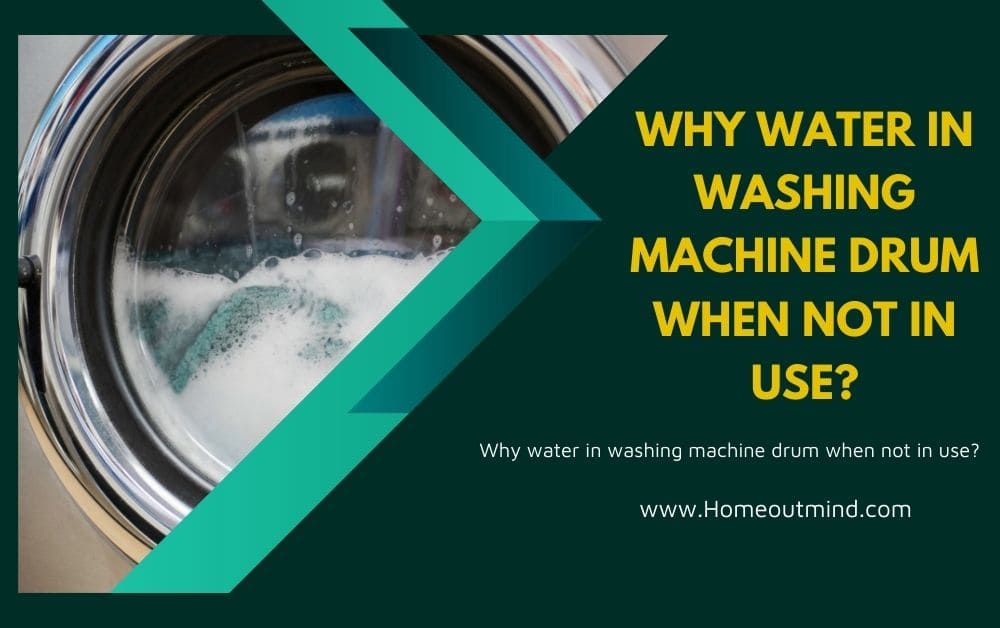Ever open your washing machine only to find a mysterious puddle where your laundry should be? Finding water in your washing machine drum when it’s not in use isn’t just surprising, it can be worrying. But before you panic, don’t worry!
There are several common explanations for this unexpected moisture, and some are actually quite harmless. However, diagnosing the right culprit is key to avoiding further damage or inconvenience.
So, let’s dive into the possible reasons why your washing machine is playing its own watery hide-and-seek game, and how to get things back on track (and dry!).

1. Leaky Water Valve: The Phantom Flusher
Sometimes, even when your machine is off, the culprit behind that water buildup could be a malfunctioning water valve.
Imagine a faucet stuck slightly open, constantly dribbling water into your drum. This can happen due to wear and tear, debris caught in the valve filter, or even internal damage.
1. Telltale Signs: This one’s pretty easy to spot. If you see clean, clear water steadily accumulating in the drum, even after a completed cycle, the valve might be to blame.
2. Fixing the Leak: First, try cleaning the valve filter (consult your manual for location). If that doesn’t do the trick, consider seeking professional repair to replace the valve and avoid potential water damage.
Remember: Don’t ignore a leaky valve, as it can waste water and lead to bigger problems down the line.
2. Faulty Drain System: The Clogged Culprit
Ever notice your machine taking an eternity to drain, or worse, leaving a soapy puddle behind?
This could be a sign of a drainage issue. Think of it like a blocked sinkpipe – water struggles to escape, leading to unwanted pools.
1. The Usual Suspects: The blockage could be in the drain hose, clogged with debris like coins or socks.
Alternatively, the drain pump itself might be jammed with hair, fabric bits, or even mineral buildup. In rarer cases, a faulty sensor could be misinterpreting water levels, hindering proper drainage.
2. Signs & Solutions: Watch out for dirty or soapy water lingering in the drum after a cycle, or unusually long drain times.
If you’re comfortable, try cleaning the drain hose (refer to your manual) and checking the pump filter for clogs. However, for complex blockages or sensor issues, professional repair might be necessary.
Remember: Regular cleaning of the drain filter can help prevent these blockages and keep your machine flowing smoothly.
3. Incomplete Drain Cycle: The Mid-Spin Mystery
Sometimes, the reason for water in your drum isn’t a leak or blockage, but simply a case of unfinished business.
Imagine your machine mid-drain when, oops, the power cuts out! Or maybe your laundry party got a little too wild, with an unbalanced load throwing things off. In these cases, the drain cycle might be interrupted, leaving some residual water behind.
1. Signs of Mid-Cycle Mayhem: This one’s subtle. If you notice a small amount of water (think puddles, not pools) in the drum after a seemingly completed cycle, the drain might not have finished its job.
2. Fixing the Finish Line: First, check if the cycle truly finished – sometimes displays can be misleading. If it did stop early, try redistributing the load for better balance and restarting the cycle.
If the issue persists, consult your manual to see if there’s a “drain and spin” option to manually complete the cycle. Remember, if power outages are frequent, consider a surge protector for your machine.
Remember: A little residual water after a cycle can be normal, but if it’s excessive or persistent, investigate further.
4. Normal Residual Water: Don’t Be Fooled by Phantom Puddles!
Before you jump to conclusions, take a deep breath. A tiny amount of water trapped in the pump or hoses is actually perfectly normal.
Remember, these parts need a bit of lubrication to function smoothly. This hidden water wouldn’t be visible in the drum and certainly wouldn’t create a puddle, so you can rest assured it’s not a cause for concern.
Think of it like a car needing oil to run properly. Your washing machine’s internal plumbing needs that small amount of water to keep things moving smoothly, without the risk of drying out and causing damage.
So, unless you’re seeing a visible pool of water, you can relax your machine is just doing its job!
5. Beyond the Usual Suspects: Diving Deeper into Watery Woes
While we’ve covered some common culprits, the world of washing machine mysteries doesn’t end there. Here are a few less frequent, but still possible, causes for that lingering water:
1. Faulty Door Seal: Imagine a leaky window in your house – a worn or damaged door seal can allow water to seep into the drum even after the cycle is finished.
Look for tears, cracks, or mildew along the seal, and consult your manual or a professional for replacement if needed.
2. Faulty Pressure Switch: This little part is responsible for sensing water levels during different stages of the cycle.
If it malfunctions, it might misinterpret the water level, leading to incomplete draining or even overfilling. Replacing the pressure switch might be necessary in such cases.
3. Clogged Air Trap: Similar to the drain hose, the air trap can also get clogged with debris, hindering proper water flow and drainage.
Cleaning the air trap is usually a simple DIY task, but consult your manual for specific instructions.
4. Detergent Residue: Excess or unsuitable detergent can leave behind stubborn suds that don’t drain effectively, creating the illusion of lingering water.
Use the recommended amount of detergent for your load and water hardness, and consider switching to a high-efficiency formula if necessary.
5. Faulty Control Board: In rare cases, the electronic brain of your machine, the control board, could be malfunctioning, leading to erratic behaviors like incomplete drain cycles or even phantom water intake.
This often requires professional diagnosis and repair.
Remember: If you’re unsure about the cause or uncomfortable tackling the repair yourself, always seek professional help to avoid further damage or safety hazards.
By understanding the possibilities and taking proactive measures, you can keep your washing machine running smoothly and avoid those unwanted watery surprises!
Expert Tips: Keep Your Laundry King Running Smoothly!
Prevention is key! Just like your car, regular maintenance can prevent water woes down the line. Here are some pro tips:
Clean the drain filter regularly: Refer to your manual for instructions, but aim for once a month (more often if you have pets or wash frequently).
Descale occasionally: Hard water can leave mineral buildup, so descale your machine according to the manufacturer’s recommendations.
Check the hoses: Inspect for cracks or leaks every few months, and replace them if necessary.
Don’t overload: An unbalanced load can stress the system and lead to drainage issues. Stick to the recommended weight limits.
Remember, sometimes even the best efforts need a little outside help. Don’t hesitate to seek professional repair for complex issues, persistent problems, or if you’re unsure about tackling things yourself.
By following these tips and knowing when to call in the experts, you can keep your washing machine running smoothly and avoid those unexpected (and unwelcome) water surprises!
I found a small amount of water in my drum after a cycle. Is this normal?
It’s completely normal to find a tiny amount of water trapped in the pump or hoses after a cycle.
This water serves a crucial purpose by lubricating these internal components, ensuring their smooth operation and extending the lifespan of your machine.
Think of it like the oil in your car engine a small amount is necessary for optimal performance. You won’t see this water directly in the drum, so unless there’s a visible puddle, there’s no need to worry.
My machine takes forever to drain, and there’s dirty water left in the drum. What’s wrong?
This scenario suggests a potential blockage somewhere in the drainage system. The usual suspects include the drain hose, which can accumulate debris like coins, socks, or hair over time.
Alternatively, the drain pump itself might be clogged with hair, fabric bits, or even mineral buildup. In rare cases, a malfunctioning sensor could be misinterpreting water levels, leading to incomplete draining.
If you’re comfortable, try cleaning the drain hose and filter as per your machine’s manual. However, for complex blockages or sensor issues, seeking professional help is the best course of action to avoid further damage.
I found clean water in the drum after turning the machine off. What’s happening?
The most likely culprit here is a faulty water valve. Imagine a faucet stuck slightly open, allowing a constant trickle of water into your drum.
This can happen due to wear and tear on the valve itself, debris caught in the filter, or even internal damage. The first step is to clean the valve filter according to your manual’s instructions.
If the issue persists, don’t hesitate to seek professional repair to prevent potential water damage and costly repairs down the line.
My power went out mid-cycle, and now there’s water in the drum. What should I do?
An incomplete drain cycle is likely the culprit in this situation. Double-check if the cycle truly finished, as displays can sometimes be misleading. If it did stop prematurely, try redistributing the load for better balance and restarting the cycle.
Many machines also have a “drain and spin” option that allows you to manually complete the cycle, regardless of where it stopped.
Remember, investing in a surge protector can help prevent future power outages and their associated laundry disruptions.
Should I clean my washing machine regularly to prevent water problems?
Absolutely! Regular maintenance is key to keeping your washing machine running smoothly and avoiding water-related issues. Aim to clean the drain filter once a month, especially if you have pets or wash clothes frequently.
You should also descale your machine occasionally based on the water hardness in your area to prevent mineral buildup. Additionally, every few months, inspect the hoses for cracks or leaks and replace them if necessary.
Finally, remember to avoid overloading the machine, as unbalanced loads can put extra strain on the drainage system.
Conclusion
Unwanted water in your washing machine can spell trouble. Leaky valves, clogged drains, even hidden mold – the suspects are many. But fear not!
Address the issue swiftly and avoid unnecessary damage. Tackle simple fixes yourself, or tap online resources for expert guidance. Remember, professional help is just a call away.
With a sprinkle of detective work and timely action, you can banish those watery woes and keep your laundry sailing smoothly!
FAQs:
Can using too much detergent cause water to stay in the drum?
Yes, excess detergent can create excessive suds that don’t drain effectively, leaving you with the illusion of lingering water.
Stick to the recommended amount for your load and water hardness, and consider switching to high-efficiency detergent if needed.
My clothes smell musty even after washing. Could water be trapped somewhere?
Mold and mildew thrive in damp environments, and trapped water can create the perfect breeding ground.
Check the rubber door seal for leaks or mildew, and run a hot empty cycle with vinegar or bleach (check your manual) to disinfect the drum.
I hear water sloshing during the spin cycle. Is this normal?
A small amount of residual water is normal during spinning, but excessive sloshing could indicate a faulty inner drum bearing or seal. If the noise is significant or worsens, seek professional help.
Should I unplug my machine when not in use to prevent water leaks?
While unplugging can offer some peace of mind, modern machines have safety features to prevent leaks even when powered off. However, if you’re concerned about power surges, a surge protector is a better option.
I tried everything, but water keeps appearing in my drum. What now?
If you’ve ruled out common causes and DIY solutions, it’s time to call in the professionals. They can diagnose the issue accurately and provide the necessary repairs to get your machine back in top shape.
Remember, timely intervention can prevent minor problems from turning into costly headaches.



